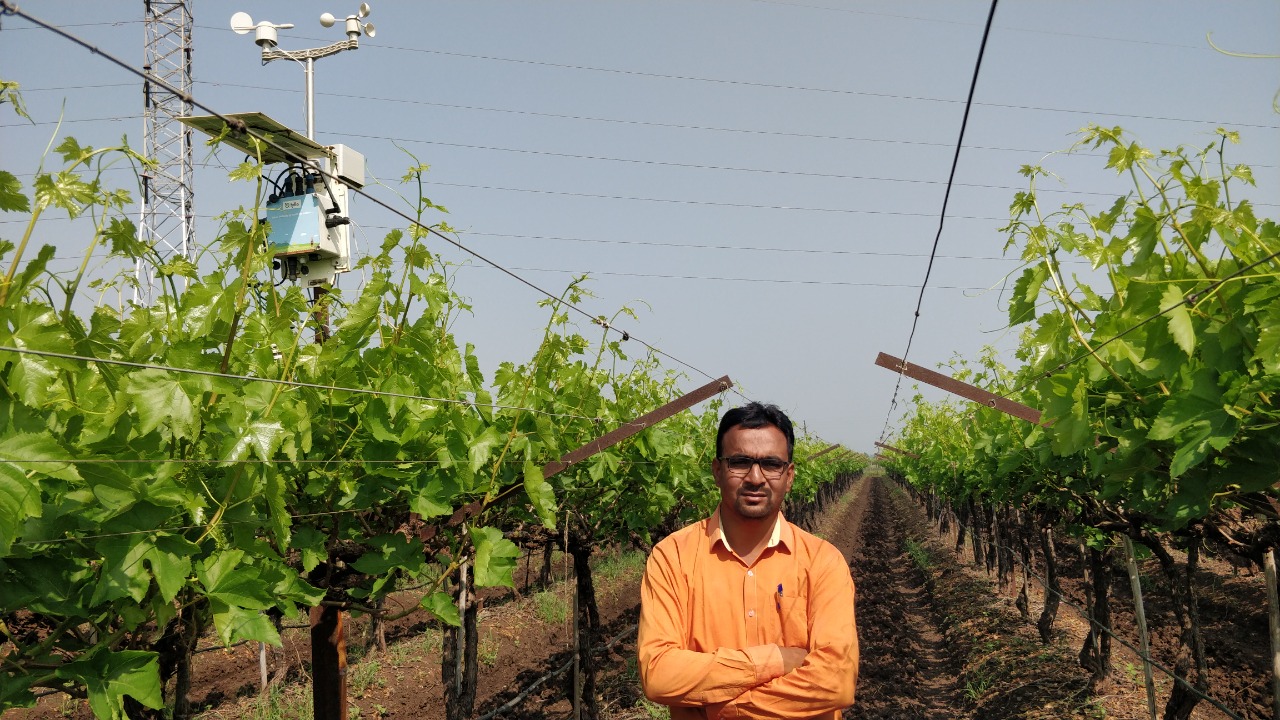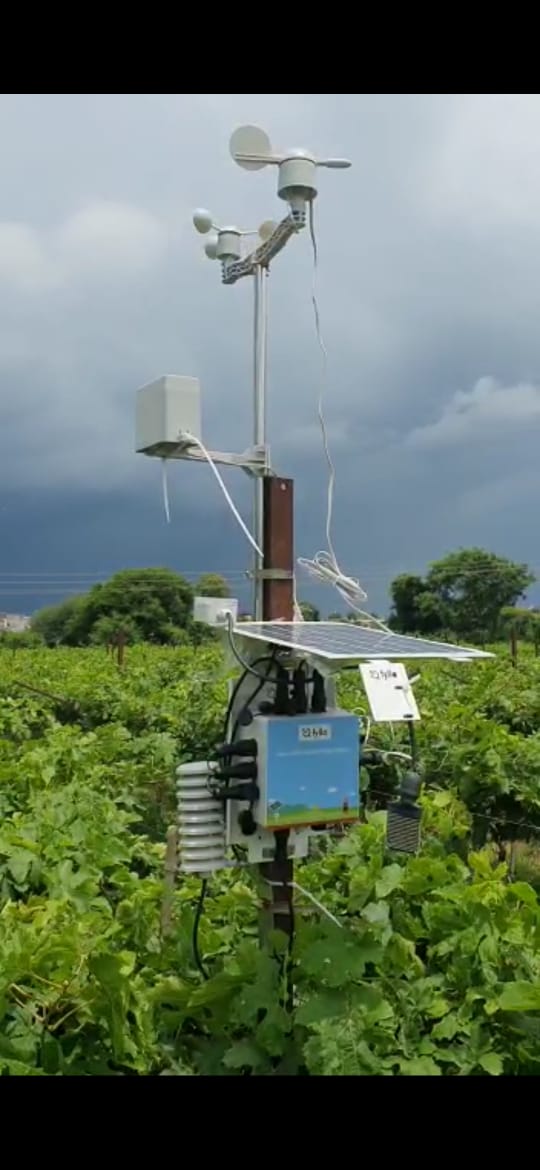
Nashik grape farmer weeds out weather vagaries with forecast station, sensors
Hundreds of grape growers from Vadali Najik village in Naphad taluka of Nashik district (Maharashtra) have been benefiting from the automated weather station and soil sensors set up by Roshan Zalte in his 15-acre vineyard about a year ago. The weather station gives short-term and long-term weather forecast (from 12 hours to 7 days) and the sensors give accurate measure of the soil moisture. Roshan shares this information with fellow growers which is helping them improve their yield while saving on input cost and water.

Thirty-one-year-old Rahul Kalade is a grape grower and a relieved man today. A few days back, he got an update on his cellphone from a friend and fellow grower, Roshan Zalte, about a high probability of rainfall in the next 48 hours. In response, Rahul immediately went for a systemic spray (water soluble) of the required fungicide and his vineyard was saved from an imminent attack of Downy mildew (grape disease).
Hundreds of grape growers from Vadali Najik village in Naphad taluka of Nashik district in Maharashtra have been benefitting from the automated weather station and soil sensors set up by Zalte in his 15-acre vineyard about a year ago. The weather station gives short-term and long-term weather forecast — ranging from 12 hours to seven days — and the sensors give accurate measure of the soil moisture. Roshan shares this information with fellow growers, which is helping them improve their yield while saving on input cost and water.
Zalte is a farmer by birth and also a qualified one. The 33-year-old used a B.Tech degree in agriculture engineering and prolonged family experience of managing a 15-acre vineyard to set an example of precision in agriculture. His deep desire to become an efficient farmer brought him closer to technology, and the solar-operated automated weather station with 11 soil sensors was a result of this yearning. “Every time I get to know about rains or temperature fluctuations in advance, I feel like I am playing god,” says Zalte jokingly.

Need for change
A farmer’s success with his crop is measured in terms of his ability to understand how much water his crop needs. A closer look at the challenges staring at farmers the world over in the 21st century reveals that floods (excess water) cause more damage than a drought (less water). Climate change has only exacerbated the problem.
Roshan grew up seeing how the availability of water or the absence of it can impact the output in a vineyard. Soon after he finished his B.Tech, Roshan turned his attention to his ancestral orchard instead of looking for a comfortable job with a multinational seed or farm input company. “This part of Nashik district receives about 700mm rainfall in a year, which is not very high. All growers in our village need to dig deep into the ground to extract water and keep the plants alive. The question that bothered me was how deep can you dig for water and for how long would that sustain. Besides, I was deeply concerned about the quality and quantity of grapes we produced,” says Zalte.
Expert help
A chance interaction, and later a two-year consultancy, with international grape consultant Rodrigo Oliva gave Zalte the answers he was looking for. “We growers look at grapevines from the outer, ignoring the complex web of roots and their interactions with soil and water below. Rodrigo told me to ‘look beneath the soil and you will find answers to your questions’. I did as he said and found the answers,” says Zalte, who put his knowledge of agriculture engineering to full use to come up with a way to optimise the use of water.
Establishing the problem
A plant goes under stress for two reasons: Excess water or less water. “We have to constantly strike the right balance between the two. The pattern of monsoon rains has become very erratic these days due to climate change. For example, I may not be expecting any rain in this month, but a sudden heavy shower hits my farm and disturbs the pesticide spray schedule for the whole month. As a result, a pest attack goes out of control and I lose a good percentage of my produce. So, I needed a way to predict rains, heat, dew and every weather variable that may have an impact on the grapevine,” he says.
Setting up the weather station
The young enterprising farmer consulted a Bengaluru-based tech start, run by two IIT graduates, to set up his own weather station on the orchard. “Initially, I opted for weather update apps, but none could provide me with accurate and reliable data. I wanted to know if it would rain in the next hour — in my village and in my vineyard. I know it sounds as if I want to play god, but imagine what it can mean for a farmer to know when it will rain and how much,” asks Zalte with a child-like curiosity, which stems from the fact that unreliable and uncertain weather patterns have left our farmers desperately searching for out-of-the box solutions.
Established at a cost of Rs 90,000, the automated weather station gives near-accurate inputs on rainfall, air speed, air moisture, temperature, soil moisture (with help from sensors), etc. Roshan uses this data to apply and decide the doses of sprays, micro- nutrients and, most importantly, schedule water application. He only applies those inputs that are required in the given situation, thus resulting in huge savings.
Precision agriculture
Will a factory owner apply more than required oil to make the engines perform with greater efficiency? It will prove counter-productive. Then why should a farmer apply more inputs (nutrients, pest repellants and water) to get optimum produce? Especially when we know now that excess use of chemical fertilisers, pesticides and water is damaging our soil and impacting our health.
Zalte made use of precision agriculture to arrive at a conclusion.
Precision agriculture is an approach to farm management that uses information technology (IT) to ensure that crops and soil receive exactly what they need for optimum health and productivity. The goal of precision agriculture is to ensure profitability, sustainability and protection of the environment.
The automated weather station and 11 sensors (installed at different places — from inside the soil to top of the grapevine) provide micro-climate data (weather information about his particular village) to understand the requirement of his soil and plants better and apply the right inputs to get a quality and bountiful produce, which gets exported to Europe.
The immediate impact was a 40% reduction in water use, 20% drop in sprays and a 100% improvement in the quality of fruit. “This is a big saving for any grower. Sensors in soil give real-time update on moisture availability. Thus, I apply water only when the soil demands. Also, availability of right amount of moisture helps the plant absorb the nutrients in the right proportion. The result is optimum expense for an optimum produce,” says Zalte.
Tangible benefits of technology
1. About 20 per cent growth in production
2. Accurate prediction of dew during winter helps prevent damage to fruit
3. About 40 per cent saving of water
4. Approx. 20 per cent savings in use of fertilizers and pesticides
5. Improved quality and better market price realization.
6. Cost savings helped Roshan buy three more acres of land.
Advantage during COVID-19 lockdown
This year, Zalte’s grape harvest got delayed due to disruption in the supply chain system during the COVID-19 pandemic. “Before using technology, we would stop watering the plants when it was ready for harvest. But now we know that plants need water even when the fruit is ready. This simple change in watering method helped improve the life of fruit during the COVID pandemic. The complete batch of grapes reached Germany 15 days late, but the quality remained intact,” says Roshan.
Also read: Blooming Phytoplankton in Antarctic ocean may positively impact climate change: Study
Data mining
The weather station installed at Zalte’s vineyard is consistently collecting micro climate (precise weather of the village) data on temperature, rainfall, air and soil moisture. This information is transmitted to Zalte through his cellphone and gets stored as historic data. Over the period of time, Zalte can use this raw historic data to form certain patterns and draw conclusions using machine learning and bring about drastic changes, if needed, in the way he manages his grape orchard.
Chemical farming Vs organic farming
Asked for his views on the eternal debate on chemical farming versus organic farming, Zalte says, “I would rather opt for residue-free farming. Not all chemicals that farmers use are harmful for humans. Good ones do their job (repelling insects and pests) and get dissolved later without leaving any residue. Precision farming advocates balanced use of chemicals for a healthy and optimum produce. A win-win for all,” he concludes.

